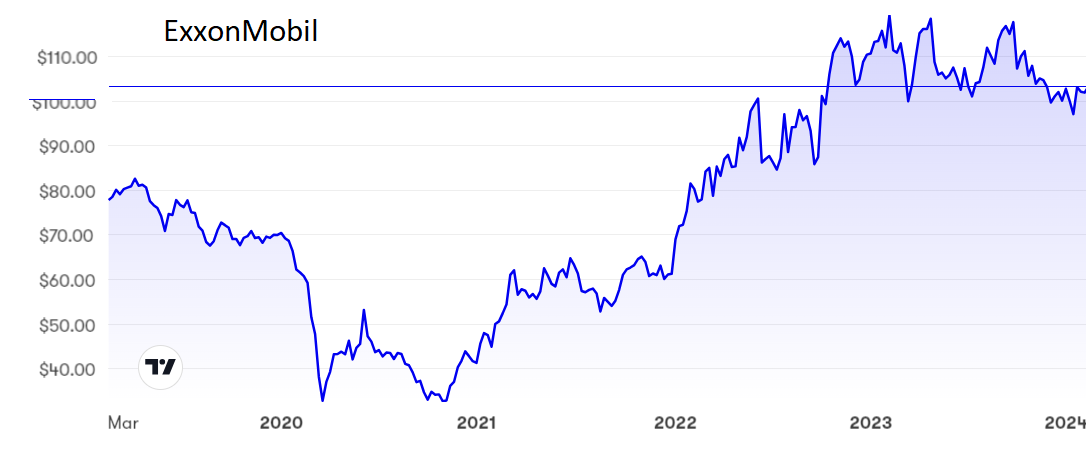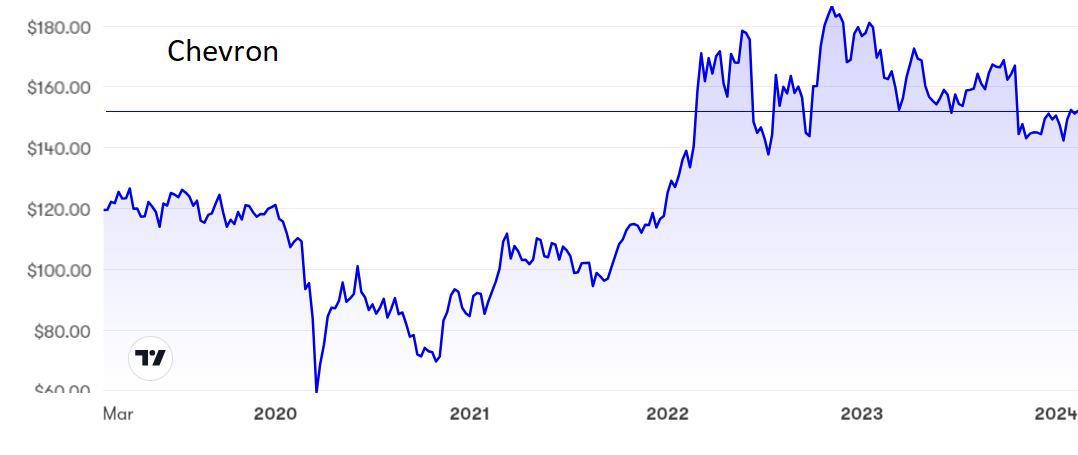Two dividend stocks back in buy territory
Revenue and profits at these firms may be down from the bumper year of 2022, but last year was otherwise the best for about 10 years, writes overseas investing expert Rodney Hobson. Our columnist also offers an update on a share defying gravity.
14th February 2024 09:08
by Rodney Hobson from interactive investor

Carbon’s days as an energy source have supposedly been numbered for decades, yet oil and gas still show no signs of dying. The sector may be a no-go area for ethical critics with green credentials but less picky investors are still enjoying solid dividends and stable share prices.
- Invest with ii: Buy US Stocks from UK | Most-traded US Stocks | Cashback Offers
While oil and gas prices have slipped back from the highs experienced after the Russian invasion of Ukraine, both Exxon Mobil Corp (NYSE:XOM) and Chevron Corp (NYSE:CVX) have partly offset lower prices with increased production. Revenue and profits may be down from the bumper year of 2022 but last year was otherwise the best for about 10 years.
ExxonMobil saw revenue down 12% to $84 billion and net income by 39% to $8 billion in the fourth quarter, taking the full-year figures to a fall of 17% in revenue and 35% in net income. However, the profit figure would have been much better without a $2.5 billion impairment charge for property in California that Exxon has been trying to sell for a year. This was painful but realistic.

Source: interactive investor. Past performance is not a guide to future performance.
Chair Darren Woods is sufficiently satisfied with the figures to promise that he will return more cash to shareholders than rivals are doing. Last year $32.4 billion was paid out in dividends and share buybacks.
Chevron saw revenue fall 16% to $47 billion in the final quarter, with net income slumping 65% to $2.24 billion. This was a bigger fall than in the previous nine months, leaving full-year revenue down 18% and net income 40% lower.

Source: interactive investor. Past performance is not a guide to future performance.
Like Exxon, it has been returning more cash to shareholders – a record $26.3 billion last year – while acquiring smaller rivals. Exxon has agreed to buy Pioneer Natural Resources Co (NYSE:PXD) to boost its shale oil production, while Chevron is taking over Hess Corp (NYSE:HES) to gain a foothold in Guyana. Both deals will be completed this year.
Environmentalists have attacked both companies for increasing their fossil-fuel capabilities rather than diversifying into greener energy but both clearly see a future for oil and gas.
Three attempts by Exxon shares to reach $120 have failed in the past 12 months and the stock is now down to $101, where the price/earnings ratio (p/e) is below the stock market average at 11.5, while the yield is above average at 3.6%.
- Sign up to our free newsletter for investment ideas, latest news and award-winning analysis
- Solid dividends are reward for owning these great companies
- 10 hottest ISA shares, funds and trusts: week ended 9 February 2024
Chevron shares have followed a similar pattern, peaking at $180 in late 2022 but slipping back to $150, with a slightly higher p/e at 14 and a yield just shy of 4%.
Hobson’s choice: I recommended Exxon at a marginally higher level early last February and the dividend has at least been some consolation for the failure of the shares to make headway. Later in the year, nearer the peak, I recommended that shareholders hold on but at the current level the buy rating is restored. Similar advice was given for Chevron, which is also back into buy territory.
Update: there is still no let-up in the bad news surrounding flaws in Boeing Co (NYSE:BA)’s 737 Max aircraft. Deliveries are delayed after it turned out that holes had been drilled the wrong distance apart in window frames on some jets. How on earth can that happen? About 50 planes need to be fixed, taking the shine off news that most of the grounded aircraft flown by Air Alaska and United Airlines Holdings Inc (NASDAQ:UAL) are back in service. Remarkably, after a sharp fall from $260 at the end of last year the shares have managed to defy gravity and the chart has formed what looks like a solid floor at $200. Nonetheless, given the absence of profits and dividends, plus the propensity for Boeing to stagger from one safety crisis to another, the shares remain a sell.
Rodney Hobson is a freelance contributor and not a direct employee of interactive investor.
These articles are provided for information purposes only. Occasionally, an opinion about whether to buy or sell a specific investment may be provided by third parties. The content is not intended to be a personal recommendation to buy or sell any financial instrument or product, or to adopt any investment strategy as it is not provided based on an assessment of your investing knowledge and experience, your financial situation or your investment objectives. The value of your investments, and the income derived from them, may go down as well as up. You may not get back all the money that you invest. The investments referred to in this article may not be suitable for all investors, and if in doubt, an investor should seek advice from a qualified investment adviser.
Full performance can be found on the company or index summary page on the interactive investor website. Simply click on the company's or index name highlighted in the article.
Disclosure
We use a combination of fundamental and technical analysis in forming our view as to the valuation and prospects of an investment. Where relevant we have set out those particular matters we think are important in the above article, but further detail can be found here.
Please note that our article on this investment should not be considered to be a regular publication.
Details of all recommendations issued by ii during the previous 12-month period can be found here.
ii adheres to a strict code of conduct. Contributors may hold shares or have other interests in companies included in these portfolios, which could create a conflict of interests. Contributors intending to write about any financial instruments in which they have an interest are required to disclose such interest to ii and in the article itself. ii will at all times consider whether such interest impairs the objectivity of the recommendation.
In addition, individuals involved in the production of investment articles are subject to a personal account dealing restriction, which prevents them from placing a transaction in the specified instrument(s) for a period before and for five working days after such publication. This is to avoid personal interests conflicting with the interests of the recipients of those investment articles.